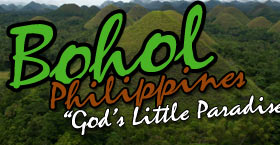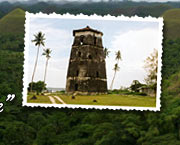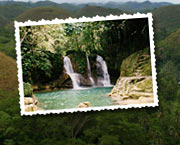Provincial Symbols of Bohol
IJsselstein, Friday, 17 May 2002 (updated: Saturday, 19 May 2007)
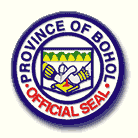 |
| The official seal of the province of Bohol |
The Boholanos are a freedom loving and independent people, who take pride in their Island, wherever they are. No wonder, the province even has its own provincial anthem.
The independent trait of the Boholanos is well known, through its history of resistance against the Spanish, American and Japanese invaders, and is expressed by the prominent placement of two large Bolos (local swords) on the official provincial flag.
The independence of the Boholano also reflects itself in the relative absence of large landownership on the island: most farmers still own their own,
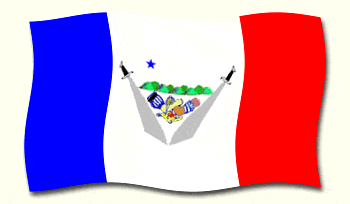
|
| The official flag of the province of Bohol. The blue stands for nobility, the white for purity and red for courage. The bolos commemorate the Tamblot and Dagohoy rebellions. The two arms in the middle depict the blood compact between Sikatuna and Legazpi, and behind that are shown the world famous Chocolate Hills. The lone star in the top left is to honor Carlos P. Garcia, the Boholano president of the Philippines. |
Where the Philippines has its national bird (Agila, the Philippine Eagle), flower (Sampaguita, Jasminium sambac), dance (Cariņosa), leaves (anahaw), and tree (narra) Bohol has also declared a number of things provincial symbols. The provincial bird is the Antolihaw or Dimodlaw (Oriolus chinensis), a bright yellow bird. It can be found all over the province, and especially during the summer it will make a loud noise: 'waw-waw-waw'
Awit sa BoholYuta kon'g minahal,
Puti ang kabaybayonan,
Cebuano translation by
|
The molave (Vitex parviflora) has been declared the provincial tree. This is a small tree, richly branched, with trifoliate leaves. The flowers are violet-colored and the fruits pea-sized and dark purple to black. It is a native to Bohol, and grows well on its limestone soils.
The provincial fruit is the Bohol mangga, or mango, (Mangifera indica Linnaeus), which does very well in Bohol. The limestone soil is responsible for a sweet and tender fruit, which is said to be the sweetest in the Philippines. About half a million mango trees grow in Bohol.
The ubi kinampay (The purple Boholano yam; Dioscorea alata Linnaeus) is rightfully elected as the provincial plant. The color of the meat of this root crop ranges from white to light to dark purple, and has an excellent aromatic taste. It is eaten cooked, alone or mixed with other vegetables. It is also dried and then used to flavor ice cream, candies and cakes. Don't leave Bohol without eating some delicious ubi ice-cream! Actually, the Boholanos so much love ubi, that they have not only declared it their provincial plant, but also celebrate the Ubi Fest every January.
Bohol HymnThis is the land I love,
Blessed with white sandy beaches,
Words and Music by
|
The white gumamela (Hibiscus rosa-sinensis Linnaeus) is the provincial flower. This magnificent white flower symbolizes the characteristics of innocence and naturalness of the Boholano. Its long bowing styles bring about a language of welcome, its tender structure with pollens characterize the people's simple tastes and modest needs. The greenish, close-knit petals represent the loyalty and constancy of the Boholano family towards each of its members, conscious of the bond that joins them together in the good and bad times.
Leaving the realm of nature, Bohol honors as its provincial hero Francisco Sendrijas, better known as Francisco Dagohoy or Dagohoy. He led what was probably the longest revolt in the Philippine history.
Finally, the provincial dance is the Kuratsa Boholana.
Jeroen Hellingman
What readers think...
| Blue Freedom Apnea wrote: |
| Monday, 6 January 2020 12:12:55 PHT |
| There is new freediving school open in Panglao, Bohol. They are non-profit organization that offer AIDA and Molchanovs courses from beginner level to instructor level. If you want to explore Balicasag island in Panglao, you can also do fun dive with them. Checkout their website is https://bluefreedomapnea.com . You can also send an enquiry to their enquiry page Send Enquiry. #freedive #freediving panglao #freediving bohol #freediving philippines |
| Le wrote: |
| Thursday, 27 December 2012 10:17:48 PHT |
| I spent a week in Tagbilaran City in 1999 working with Habitat for Humanity at the Mount Banat'i development. Every day I heard the Bohol Hymn being sung. I got goosebumps every time I heard it -- and I still do. I long to visit Bohol again. |
| Aaron Bryant wrote: |
| Saturday, 13 March 2010 22:43:24 PHT |
| Thank you for your article and the great information about Bohol. I live in the U.S., but recently had the opportunity to visit various islands of the Philippines for about 3 weeks. I fell in love with the people and places of Bohol. I was even blessed to meet the Mayor of Catigbian. Looking through your pictures put a smile on my face as I recognized many of the places. Your information gives me a better appreciation for the history and heart of the island and its people. |
| Lilia Cajes wrote: |
| Tuesday, 1 December 2009 10:34:44 PHT |
| The Bohol Hymn "Awit Sa Bohol" sheet music is in the picture section on the website www.talibon.com It can be freely downloaded as a JPG picture. |
| Ken Rose wrote: |
| Thursday, 20 August 2009 16:48:16 PHT |
| Where can I obtain the sheet music for the Bohol Hymn? There are many sites that have the words, videos where it is sung but I cannot find the sheet music so I can play it. |
Read all 29 comments by readers.
Also give your comments on this article
We reserve the right to remove or edit comments posted on this website. Please read our conditions of use for details. You can use <i>italics</i>, <b>bold</b>, <p> new paragraph, <a href="url">link</a>. Other markup will be removed. Use of the forums for advertising is prohibited. Enterprises located in Bohol can request to be added to the business directory.
